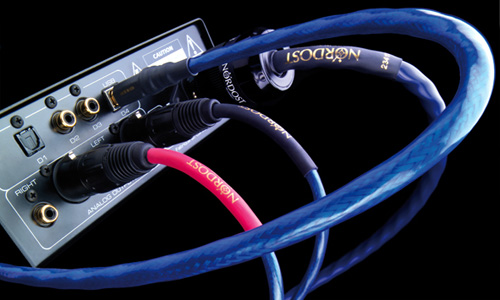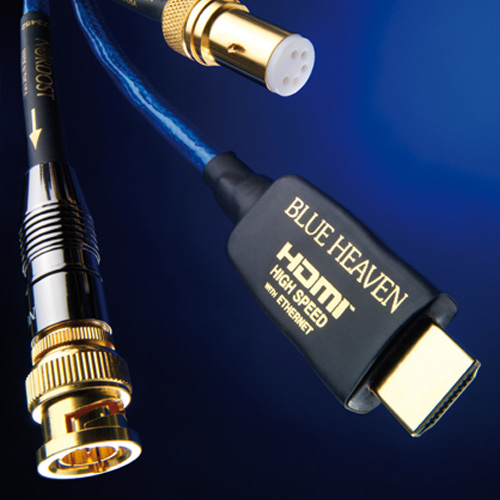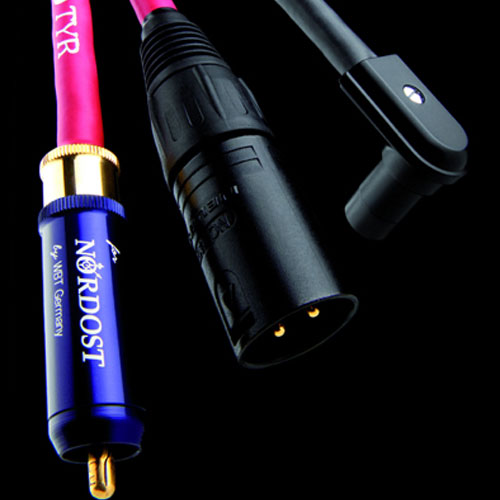Dedicated Cables For Source Components
Digital cables igital cables now have a bewildering variety of different and distinct standards. Once upon a time, the only one the audio enthusiast had to worry about was S/PDIF, the common 75-ohm coaxial connection. Even then, it was remarkable how many specialist cables were offered that did not adhere to the clearly defined 75-ohm transmission standard, either in the cable itself (many of which were not even coaxial designs) or the connectors. Yet the simple fact is that both ends of the transfer path expect to see 75-ohm termination. Alter the electrical characteristics of the connection and you will cause data reflections that will distort the signal. No wonder they all sounded so different! If all digital cables and their terminations within the equipment behaved as perfect 75-ohm transmission lines, free of any mechanical or electrical interference, you would hear no difference between digital leads -- but we are a long, long way from that. The first and most important step in achieving good-quality data transfer is to control the controlables -- and that means ensuring that your cable, and its connectors, comply with the correct impedance standard. That means 75 ohms for S/PDIF, with either genuine 75-ohm RCA connectors or the far better BNC coaxial option.
This episode encapsulates the ongoing issues around digital transfer. It doesn’t matter whether you are talking about USB, FireWire, HDMI or any of the other new audio-only or A/V standards, each one has a precisely defined set of electrical characteristics and these should be your starting point in selecting digital cables. Look for dedicated designs in which the manufacturer acknowledges (and complies with) the standards that apply, whilst improving performance through materials, construction and the quality/choice of the connectors. Tonearm cables ust like digital cables, tonearm cables have a clearly defined set of electrical characteristics to which they should conform, but this is combined with the added challenge of passing the smallest and most fragile signal in the system. Most CD players have an output level in the region of 2.0V, while some will stray as high as (or higher than) 4V. Compare that to the 0.4mV output of the average moving-coil cartridge. That’s 5000 times smaller than the average CD player. With such a tiny signal level, inflicting irreparable damage is easy to do, damage the effects of which are then massively amplified by the rest of the system. That’s why analog setup is so critical, why even tiny shifts in cartridge alignment can be heard so clearly, and why you’d better make sure the cabling attached to your tonearm is doing its job properly, especially as it forms part of the electrical damping seen by the cartridge generator. Now you see why having the correct electrical characteristics becomes so critical. But to make matters worse, many of the cables that are actually supplied with tonearms are not even close to good enough in quality. You wouldn’t pass the signal from a $10,000 CD player down a $25 lead, but even experienced audiophiles regularly do that with the miniscule output of their mega-expensive cartridges. It indicates just how far below the audio radar tonearm cables fly -- ironic, given that getting this cable wrong can do more sonic damage than any other cable in the system.
Nearly all tonearm cables will be thinner or use fewer conductors than their standard line-level equivalents. That’s because capacitance is the most critical characteristic of all -- and that’s what rules out most general interconnects. With two or more volts doing the driving, other factors assume greater importance. But with the minute signal from a moving-coil cartridge, excessive capacitance will both slug the generator and kill the signal, almost literally making it sound like it’s running through sand, destroying the life, immediacy and resolution that keep record replay at the top of the hi-fi tree. There are also a whole host of tonearm-specific termination options to consider, and dedicated cables should offer all of these as standard, with some manufacturers also using their own, individual connectors. Again, you should be able to special order these. Balanced connection is something that both makes sense (the cartridge is an inherently balanced generator) and is becoming increasingly common, so this is another termination option that should be offered. What all this tells you is that, as well as budgeting for your record player, tonearm and cartridge, you need to check what cable, if any, is supplied and allow for a dedicated solution as necessary. |

 ource components such as
digital transports and record players require dedicated cable designs to deliver optimum
performance. Both digital signals and those from record players have precisely defined
electrical requirements and characteristics that must be followed if the cables are not to
degrade the quality and integrity of the signals they pass. These cables can make or break
the performance of a system, simply because they are placed so early in the signal path.
Damage that is done to or confusion that enters the signal here can never be corrected
further down the path, so considerable care should be taken in selecting cables for these
critical applications.
ource components such as
digital transports and record players require dedicated cable designs to deliver optimum
performance. Both digital signals and those from record players have precisely defined
electrical requirements and characteristics that must be followed if the cables are not to
degrade the quality and integrity of the signals they pass. These cables can make or break
the performance of a system, simply because they are placed so early in the signal path.
Damage that is done to or confusion that enters the signal here can never be corrected
further down the path, so considerable care should be taken in selecting cables for these
critical applications. The next popular digital standard for
audio use was the balanced AES/EBU standard. This depended on a 110-ohm impedance, with
appropriate XLR connectors, yet it was remarkable how many cable companies simply put
different plugs on the wire that they were offering for 75-ohm digital transfer! Once
again, you must have a 110-ohm cable with 110-ohm connectors to derive any benefit from
the AES/EBU option on your equipment.
The next popular digital standard for
audio use was the balanced AES/EBU standard. This depended on a 110-ohm impedance, with
appropriate XLR connectors, yet it was remarkable how many cable companies simply put
different plugs on the wire that they were offering for 75-ohm digital transfer! Once
again, you must have a 110-ohm cable with 110-ohm connectors to derive any benefit from
the AES/EBU option on your equipment. In fact, there are two cables in most
tonearm setups; the one inside the 'arm and the one that joins the base of the 'arm to the
phono stage. The optimum arrangement is having a continuous run of cable that carries the
signal all the way from the cartridge tags to the input sockets on the electronics -- a
cable whose technology, materials and construction matches the rest of the cables in the
system, a continuity that’s even more important here than anywhere else. Even if the
external and internal cables on your tonearm are separate, you should still try to achieve
this consistency, and most serious cable manufacturers offer a dedicated internal tonearm
wire that can be retrofitted to an existing 'arm, or specified when you order a new one.
In fact, there are two cables in most
tonearm setups; the one inside the 'arm and the one that joins the base of the 'arm to the
phono stage. The optimum arrangement is having a continuous run of cable that carries the
signal all the way from the cartridge tags to the input sockets on the electronics -- a
cable whose technology, materials and construction matches the rest of the cables in the
system, a continuity that’s even more important here than anywhere else. Even if the
external and internal cables on your tonearm are separate, you should still try to achieve
this consistency, and most serious cable manufacturers offer a dedicated internal tonearm
wire that can be retrofitted to an existing 'arm, or specified when you order a new one.